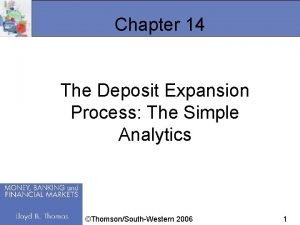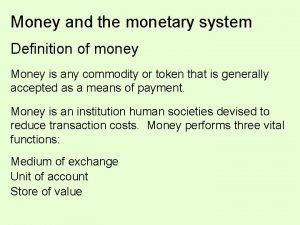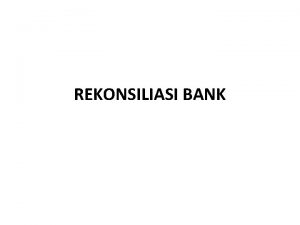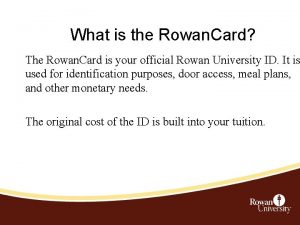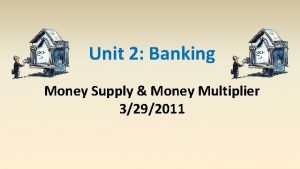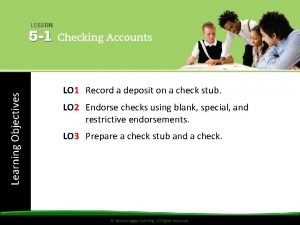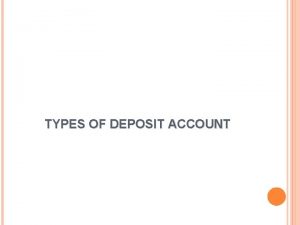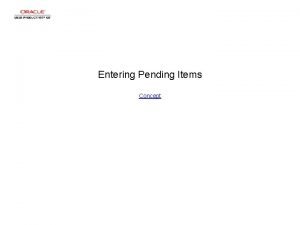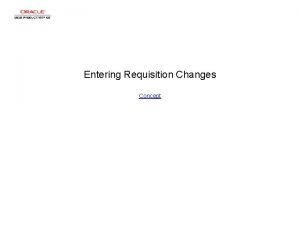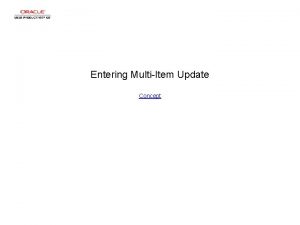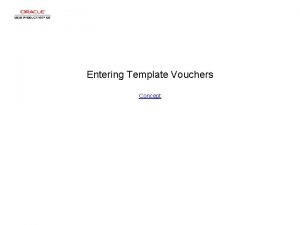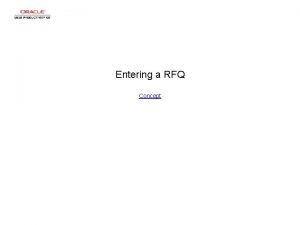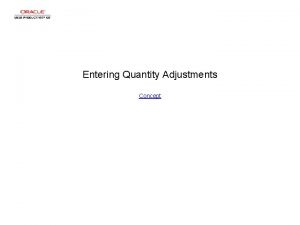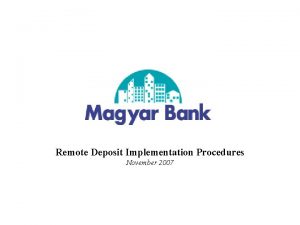Entering a Regular Deposit Concept Entering a Regular
























































- Slides: 56

Entering a Regular Deposit Concept

Entering a Regular Deposit

Entering a Regular Deposit Step 1 Begin by navigating to the Totals page. Click the Scroll Down arrow.

Entering a Regular Deposit Step 2 Click the Accounts Receivable menu.

Entering a Regular Deposit Step 3 Click the Payments menu.

Entering a Regular Deposit Step 4 Click the Online Payments menu.

Entering a Regular Deposit Step 5 Click the Regular Deposit menu.

Entering a Regular Deposit Step 6 Click the Add a New Value tab.

Entering a Regular Deposit Step 7 Enter the desired information into the Deposit Unit field. Enter "US 003".

Entering a Regular Deposit Step 8 Click the Add button.

Entering a Regular Deposit Step 9 Use the Totals page to enter information and control totals for a new deposit, or delete a deposit. The Totals page is unavailable if the deposit has been reconciled with a bank statement.

Entering a Regular Deposit Step 10 Use the Accounting Date field to enter the accounting date for each payment and for all pending items created from the payment. You can override the date on the Regular Deposit - Payments page. The system validates the accounting date to make sure it falls within the open period for the business unit and transaction type as defined on the Open Period page for the business unit.

Entering a Regular Deposit Step 11 Click in the Bank Code field.

Entering a Regular Deposit Step 12 Enter the desired information into the Bank Code field. Enter "USBNK".

Entering a Regular Deposit Step 13 Click in the Bank Account field.

Entering a Regular Deposit Step 14 Enter the desired information into the Bank Account field. Enter "CHCK".

Entering a Regular Deposit Step 15 Use the Deposit Type field to specify the code for the payments for which the deposit is made. In this example, the deposit is made for customer receipts. Click in the Deposit Type field.

Entering a Regular Deposit Step 16 Enter the desired information into the Deposit Type field. Enter "C".

Entering a Regular Deposit Step 17 In the Control Currency field, enter a currency code if the same currency is used for all of the payments.

Entering a Regular Deposit Step 18 Specifying a control currency at the deposit level is optional. If you enter currency at this level, all payments in the deposit must have this same currency. To take advantage of multicurrency processing, leave the Control Currency field blank and specify currency at the payment level. The next page in this component, the Payments page, enables you to enter a different currency for each payment in the deposit.

Entering a Regular Deposit Step 19 Click in the Control Currency field.

Entering a Regular Deposit Step 20 Enter the desired information into the Control Currency field. Enter "USD".

Entering a Regular Deposit Step 21 Use the Control Total Amount and Count fields to enter the control totals for the amount and count of the payments in this deposit. You can have a zero-total deposit if the payment amounts offset each other.

Entering a Regular Deposit Step 22 Click in the Control Total Amount field.

Entering a Regular Deposit Step 23 Enter the desired information into the Control Total Amount field. Enter "30000".

Entering a Regular Deposit Step 24 Click in the Count field.

Entering a Regular Deposit Step 25 Enter the desired information into the Count field. Enter "2".

Entering a Regular Deposit Step 26 Use the Received field to enter the date when either the bank or your company received the payment. Because of normal processing delays, the Received date may be different from the Entered date.

Entering a Regular Deposit Step 27 Click the Payments tab.

Entering a Regular Deposit Step 28 Use the Payments page to enter details about each payment in a regular deposit. The more information you can provide on this page, the easier it will be to work with the payment worksheet.

Entering a Regular Deposit Step 29 The Balance field displays the status for the deposit. When the amount total and number of entered payments equals the control amount and count from the Totals page, the status changes from Not Balanced to Balanced. The total amount of all the payments in the deposit must match the control totals on the Totals page before you can create a payment worksheet.

Entering a Regular Deposit Step 30 Note that you cannot update payment information for a deposit that has been reconciled with a bank statement.

Entering a Regular Deposit Step 31 Use the Payment ID field to identify a payment. You can enter the check number or any other identifying number. Enter the desired information into the Payment ID field. Enter "22480".

Entering a Regular Deposit Step 32 The Accounting Date field displays the payment date, using the accounting date on the Totals page as the default. The system validates the payment date to make sure that the date falls within the open period for the business unit and transaction type as defined on the Open Periods page for the business unit. The payment date may be different from the deposit date, if you use the postmark date from checks. The payment date affects earned discounts, so it's important that it is accurate.

Entering a Regular Deposit Step 33 Click in the Amount field.

Entering a Regular Deposit Step 34 Enter the desired information into the Amount field. Enter "10000".

Entering a Regular Deposit Step 35 Click in the Customer ID field.

Entering a Regular Deposit Step 36 Enter the desired information into the Customer ID field. Enter "1009".

Entering a Regular Deposit Step 37 Click in the Business Unit field.

Entering a Regular Deposit Step 38 Enter the desired information into the Business Unit field. Enter "US 003".

Entering a Regular Deposit Step 39 Click the Add a new row button.

Entering a Regular Deposit Step 40 Enter the desired information into the Payment ID field. Enter "200156".

Entering a Regular Deposit Step 41 Click in the Amount field.

Entering a Regular Deposit Step 42 Enter the desired information into the Amount field. Enter "20000".

Entering a Regular Deposit Step 43 Click the Detail References link to open the Detail Reference Information page, where you create deductions, pay, or write off all or part of an item, and create on-account payments or prepayments. Click the Detail References link.

Entering a Regular Deposit Step 44 The Detail Reference Information page functions like a worksheet. It enables you to list the items to which you are applying the payment and enter the appropriate entry type for each item.

Entering a Regular Deposit Step 45 Click in the Item ID field.

Entering a Regular Deposit Step 46 Enter the desired information into the Item ID field. Enter "4400012".

Entering a Regular Deposit Step 47 Click in the Unit field.

Entering a Regular Deposit Step 48 Enter the desired information into the Unit field. Enter "US 003".

Entering a Regular Deposit Step 49 Click in the Customer field.

Entering a Regular Deposit Step 50 Enter the desired information into the Customer field. Enter "1009".

Entering a Regular Deposit Step 51 Click the OK button.

Entering a Regular Deposit Step 52 Notice that the deposit status is Balanced. This means that the total amount of items and the number of payments you entered now equals the amount and number entered in the Control Total Amount and Count fields, respectively, on the Totals page.

Entering a Regular Deposit Step 53 Click the Save button.

Entering a Regular Deposit Step 54 You have successfully entered a regular deposit for payments. In summary, you enter regular deposits to update the People. Soft Receivables system with payments that have been deposited in your bank. End of Procedure.
 3 tier banking system
3 tier banking system Which grammar generates regular language?
Which grammar generates regular language? International association of deposit insurers
International association of deposit insurers Ri temporary caregiver insurance
Ri temporary caregiver insurance Deposit slip example
Deposit slip example Deposit
Deposit Culture refers to the cumulative deposit of knowledge
Culture refers to the cumulative deposit of knowledge Adcb aed to inr
Adcb aed to inr Deposit multiplier
Deposit multiplier Deposit pricing methods
Deposit pricing methods Notational amount
Notational amount Currency deposit ratio
Currency deposit ratio Managing and pricing deposit services
Managing and pricing deposit services Definition of money
Definition of money Simpanan giro (demand deposit)
Simpanan giro (demand deposit) Net deposit drain
Net deposit drain Myjackscard
Myjackscard Zero deposit scheme pros and cons
Zero deposit scheme pros and cons Utep direct deposit
Utep direct deposit Ready cash segment
Ready cash segment Safe deposit cabinet management system
Safe deposit cabinet management system Rekonsiliasi bank
Rekonsiliasi bank Deposit multiplier
Deposit multiplier Key concept
Key concept Money multiplier economics
Money multiplier economics Chapter 4 checking accounts answer key
Chapter 4 checking accounts answer key Deposit pricing strategies
Deposit pricing strategies Examples of benthic organisms
Examples of benthic organisms Jmu isss
Jmu isss Rowan university rowan bucks
Rowan university rowan bucks Deposit creation
Deposit creation Multiple deposit expansion
Multiple deposit expansion Gssp ncsu
Gssp ncsu Mathematical literacy grade 11 simple and compound interest
Mathematical literacy grade 11 simple and compound interest The formula for the simple deposit multiplier is
The formula for the simple deposit multiplier is Rekonsiliasi adalah
Rekonsiliasi adalah A savings option many employers offer is
A savings option many employers offer is Hobo dough
Hobo dough Deposit iq bond
Deposit iq bond Posit deposit
Posit deposit Equwak
Equwak Gcu annuity
Gcu annuity Ephesians 1:13
Ephesians 1:13 Required reserve ratio
Required reserve ratio You take 100 you had kept under your mattress and deposit
You take 100 you had kept under your mattress and deposit What is deposit creation
What is deposit creation Multiple deposit creation
Multiple deposit creation List the steps for preparing a check stub.
List the steps for preparing a check stub. No deposit no return bottles
No deposit no return bottles Contra entry for cash deposit in bank
Contra entry for cash deposit in bank Agdao coop contact number
Agdao coop contact number What are the two main types of glaciers
What are the two main types of glaciers Differentiate actual and ideal self
Differentiate actual and ideal self Contoh selling concept
Contoh selling concept How do wolf packs form on expressways
How do wolf packs form on expressways Chapter 4 safe driving rules and regulations
Chapter 4 safe driving rules and regulations Gotowebnar
Gotowebnar








